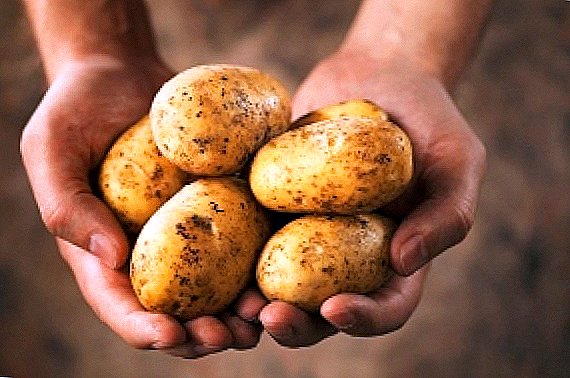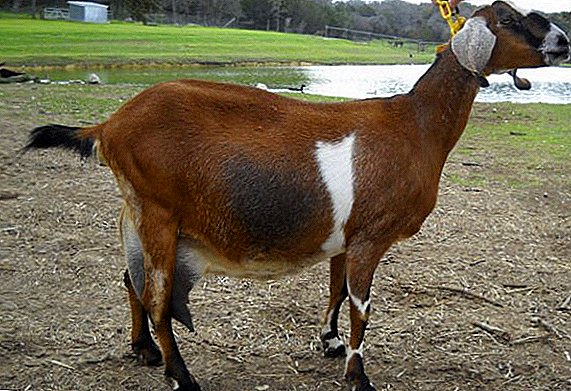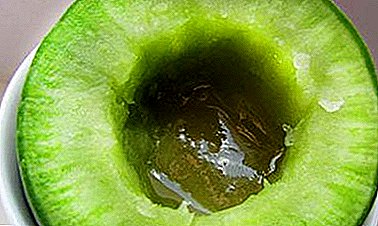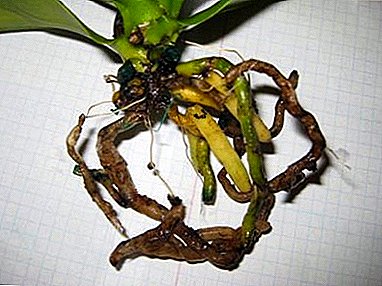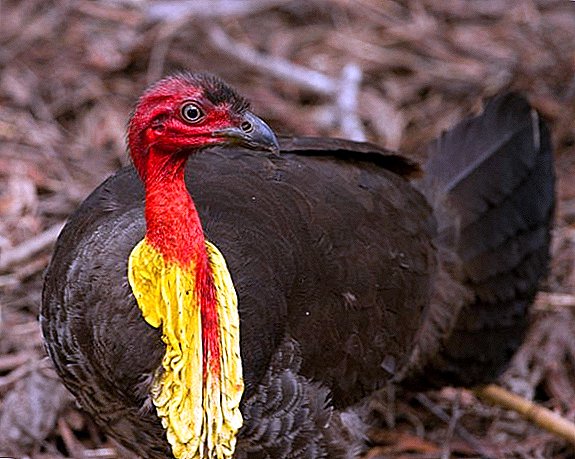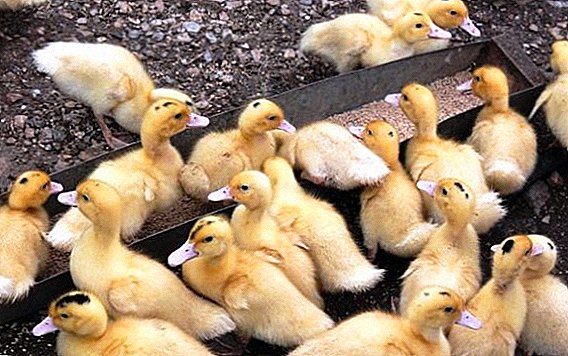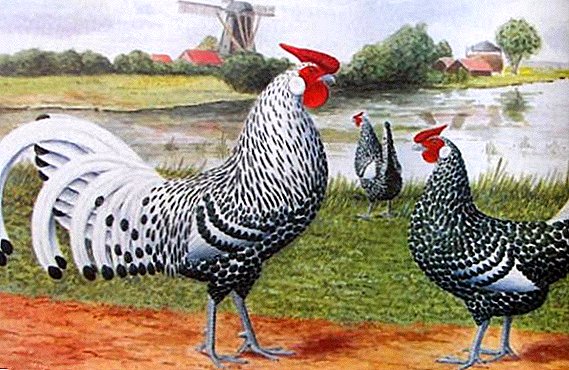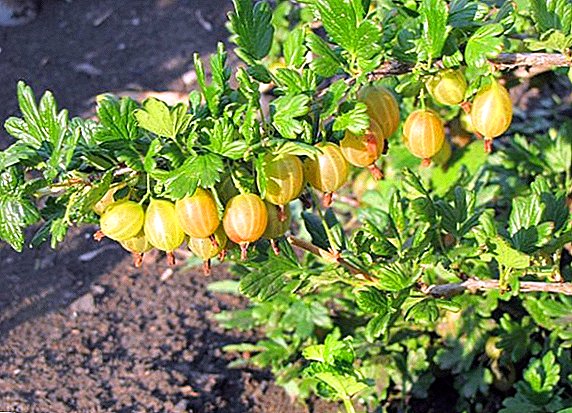 Gooseberry is a common berry for growing in mid-latitudes. The rate of growth and fruiting bushes makes it a leader among other berries. Today we will look at a detailed description of Honey gooseberry, which also bears the name of "northern grapes", and also discuss the features of its cultivation.
Gooseberry is a common berry for growing in mid-latitudes. The rate of growth and fruiting bushes makes it a leader among other berries. Today we will look at a detailed description of Honey gooseberry, which also bears the name of "northern grapes", and also discuss the features of its cultivation.
History of breeding varieties
The yellow gooseberry Honey is bred by breeders of the All-Russian Research Institute of Horticulture named after I.V. Michurin. The exact date and surname of the breeder who was engaged in this variety is not indicated.
Did you know? Gooseberries began to be grown back in Kievan Rus in the 11th century, then the berry was then called “bersen” or “agryz”. Already much later, the gooseberry was introduced to Western Europe - at the beginning of the XVI century, and it appeared in North America at the beginning of the XVIII century.
Description of the bush
The shrub of this variety of gooseberry is a vigorous, can reach a height of 1.5 m. The shrub has a sprawling crown, the leaves are small, rich green in color with an olive tinge. They have a blade shape, the edge of the sheet - rounded-toothed. The bush consists of a set of shoots of medium thickness, which are painted in dark gray with a brown tint color. The shoots of the bush are densely covered with sharp thorns.
Learn how to harvest gooseberries for the winter.
Description of berries
The berries on the gooseberry bush ripen quite a lot, they are large, weight - about 6 g, have a rounded or pear-shaped shape. In a mature state, they acquire a golden hue, the skin becomes thin and elastic. The berry itself during the period of maturity acquires a soft structure. Such fruits are as sweet as they contain 17% sugar and have a characteristic pronounced honey aroma. 
Disease and pest resistance
Honey Gooseberry is considered unstable to the destruction of pests and diseases. Especially often the plant affects powdery mildew. Brown spots appear on the leaves, which eventually spread through the plant and cause the leaf plates to fall off. The disease also affects plant development and significantly reduces yields.
Read also how to multiply gooseberries, how to cure it, plant it and cut it off.Among the common diseases of the gooseberry Honey are also:
- anthracnose - brown small spots that can be found on all parts of the plant, over time they merge into large spots and become the cause of the cessation of gooseberry development ;.
- gray rot - putrefaction on the berries for no apparent reason, which eventually destroy the entire crop;
- white spot - characterized by the appearance of brown spots on the deciduous parts of the plants, which in the course of the development of the disease become white with a dark border;
- columnar and cup rust - formation of yellow bulges on the reverse side of the leaves.
 The most common pests that affect gooseberry bushes are:
The most common pests that affect gooseberry bushes are:- shoot aphid - the development of the shoots and the plant as a whole stops, the shoots are bent, the leaves curl;
- gooseberry moth - the pest eats all the leaves on the plant;
- sawfly - pest laying eggs on the deciduous parts of plants, over time, only the veins remain from the leaves;
- mothfire - lays eggs on flowers, in the end, after the formation of the ovary, the berries turn red and rot.
Did you know? Gooseberry was the most widely spread in the world in the 19th century, when new large varieties were introduced in England. At the moment there are about 1500 varieties of gooseberry, grown in different parts of the world.
Drought resistance and winter hardiness
Honey is considered to be a frost-resistant variety, so winter is not terrible for him, but only under the condition of cultivation in middle latitudes, which are characterized by not-too-frosty winters. The variety is also resistant to drought, but do not neglect watering, as only in the case of obtaining a sufficient amount of fluid bush it will normally bear fruit.
Check out the popular gooseberry varieties.
Lighting Requirements
Gooseberry is a very light-loving plant and should receive a sufficient amount of sunlight. Under the influence of sunlight, fruit ripening occurs, therefore, the bush should be planted in an open area so that it is not obscured by buildings or other plants. Normally, the plant belongs to the drafts, but the stagnation of air can badly affect the bushes. 
Soil requirements
Honey Gooseberry grows well on loose, fertile soil and prefers slightly acidic or neutral soil. This plant is suitable for all types of land, except for peat, acidic and heavy clay varieties. The plant grows best on light fertile medium loams and sandy loams. It is not recommended to plant a gooseberry bush on the territory where the groundwater is too close to the surface, the norm is more than 1.5 m. In this connection, do not plant the plant in lowlands or depressions.
Time and landing scheme
To start planting bushes can be both in the spring and in the autumn periods. If the landing will be made in the fall, then you need to have time to plant two weeks before the frost. If the planting of the plant will be in the spring, then it is necessary to have time to plant a bush before buds begin to open on other bushes.
Important! It is forbidden to plant gooseberries in the area where currant or raspberry used to grow, as these plants greatly deplete the soil and gooseberry bush may not settle down.The landing process should be prepared in advance. To do this, two weeks before the planned procedure, it is necessary to carry out some manipulations. Prepare the plot, removing all the weeds, digging and leveling the soil surface (large clumps of earth are broken by a rake). The size of the pit for planting a bush should correspond to a value of 50 × 50 cm, depth - 60 cm. Conditionally separate the layers that are dug out from the marked area: fold the first half of the soil in one direction and the second half in the other. In that part of the soil, which was closer to the surface, add 7 kg of humus, 50 g of double superphosphate, 40 g of potassium sulfate. Everything is thoroughly mixed. The bottom layer of soil is mixed with river sand (1 bucket). Bushes should be planted with a distance of at least 1.5 m from each other. Rows should be located at a distance of at least 2 meters.
Basics of seasonal care
It is important not only to choose the right place and perform the planting process, but also to provide decent care for the plant, which will become the basis for high-quality and abundant fruiting.
Soil care
Given that the root system of the plant is located at a depth of 40 cm from the ground surface, the gooseberry requires abundant, but rare watering. It is necessary to regulate the amount of liquid poured under the bush independently taking into account the weather conditions: water more abundantly and more frequently in drought than in the rainy period.
Important! If the rains are too frequent and heavy, artificial watering should be stopped..Particular attention should be paid to watering during the formation of the ovary, flower buds for the next year (the period from mid-May to early June) and fruit ripening (from early to mid-June). We must not forget about regular watering during the preparation of the bush for wintering (early September - mid-October). The amount of water poured at a time under one bush, should be equal to 3-5 buckets, depending on the age of the plant and weather conditions. You can water no more than once a week.
 Watering should be done as close as possible to the soil, under the root. In order for the process to be as efficient as possible, it is recommended to dig several grooves 15 cm deep near the bush, departing 40 cm from the base of the plant. Water is poured first into the excavated depressions and afterwards under the base. The process of mulching is justified if it is too hot outside and all the water that is watered on the plant evaporates at an enormous rate. In order to retain moisture in the soil for as long as possible, it is recommended to overlap the root area with mowed grass and pour a thin layer of compost or peat on top.
Watering should be done as close as possible to the soil, under the root. In order for the process to be as efficient as possible, it is recommended to dig several grooves 15 cm deep near the bush, departing 40 cm from the base of the plant. Water is poured first into the excavated depressions and afterwards under the base. The process of mulching is justified if it is too hot outside and all the water that is watered on the plant evaporates at an enormous rate. In order to retain moisture in the soil for as long as possible, it is recommended to overlap the root area with mowed grass and pour a thin layer of compost or peat on top.Gooseberry - a storehouse of vitamins.Loosening the soil can be combined with weeding, which is required to remove weeds in the root zone of the plant. In this case, the weeds interfere with the air circulation and take part of the necessary nutrients. Loosen the soil after each watering of the plant, so that the roots receive oxygen, and the soil at the roots does not crack. Be especially careful during loosening and weeding, so as not to damage the root system of the plant, as some roots may come as close as possible to the soil surface.
Top dressing
Organic and mineral fertilizers are an integral part of the normal development of plants and their abundant fruiting, so you should pay particular attention to this aspect in the care of Honey gooseberries. In the spring, before buds bloom, it is necessary to feed the plant with a mixture of urea (15 to 30 g per 1 sq. M, depending on the age of the plant) and boric acid powder (10 g per 1 sq. M.). After applying the fertilizer, dig up or loosen the root patch. 
Once every two years, in the spring, before the plant begins to bloom abundantly, feed it with a mixture of rotted manure or compost (5 l), simple superphosphate (50 g), potassium chloride or potassium nitrate (20 g), wood ash (1 cup) per square meter. After fertilization, the soil is loosened and watered with a small amount of water. At the beginning of the summer period, when the first ovary is formed, it is recommended to feed the bushes with a mixture of nitrophoska (20 g) and potassium humate (40 g) per 10 liters of water.
We advise you to familiarize yourself with the agrotechnics of growing such gooseberry varieties as: "Kolobok", "Komandor" and "Grushenka".Under one bush at a time poured at least 20 liters of solution. In spring, when the harvest is gathered, it is necessary to feed the bushes with any complex phosphorus-potassium mixtures that do not contain nitrogen. It will cause the active formation of green mass, the growth of shoots, which will make it difficult for the plant to move to the "sleeping" phase. Purchase fertilizers need to be in accordance with the instructions on the package.
Cropping and crown formation
By the age of five gooseberry bush reaches a huge size, it is considered to be fully formed adult plant. In order to prevent the thickening of the crown and lower yields, it is recommended to prune shoots annually in the spring and autumn periods. Moreover, due to the timely removal of dead, damaged shoots, it is possible not only to simplify the task of harvesting, but also to prevent the development of diseases and the destruction of bushes by pests.  In the process of pruning can not forget about the main fruit-bearing branches - five or seven years old, they are cut to the point of the third branch, shoots that are older - to the fourth branch. The oldest shoots, older than ten years old, must be cut at the base in order to give place to the formation of new skeletal fruit-bearing shoots. Young shoots pruned is not recommended, as they bear good fruit.
In the process of pruning can not forget about the main fruit-bearing branches - five or seven years old, they are cut to the point of the third branch, shoots that are older - to the fourth branch. The oldest shoots, older than ten years old, must be cut at the base in order to give place to the formation of new skeletal fruit-bearing shoots. Young shoots pruned is not recommended, as they bear good fruit.  In the fall, sanitary pruning is required. To do this, all weak, broken, deformed and curved shoots that thickened the crown of the bush are cut to the point of growth. They interfere with the normal penetration of light and can cause the development of fungi and viruses. The cutting process must be carried out with a sharp and disinfected instrument. The slices are lubricated with copper sulfate-based liquid (10 g of the product are used for 1 l of water), after which the garden pitch is used to seal the slices.
In the fall, sanitary pruning is required. To do this, all weak, broken, deformed and curved shoots that thickened the crown of the bush are cut to the point of growth. They interfere with the normal penetration of light and can cause the development of fungi and viruses. The cutting process must be carried out with a sharp and disinfected instrument. The slices are lubricated with copper sulfate-based liquid (10 g of the product are used for 1 l of water), after which the garden pitch is used to seal the slices.
Preparing for the winter
In order for the plant to endure winter well, it is necessary to properly prepare it for the cold. Initially, it is recommended to clean the near-stem circle, on which weeds, fallen leaves and fruits, and dry shoots are located. This is necessary in order not to create favorable conditions for pathogens and fungi. Next, the soil around the plant gently dig up and loosen.
See also other fruit shrubs: algae algae, goji, grapes, raspberries, currants, sea buckthorn, sunberry and dog rose.If the bushes are adults, it is recommended to tie all the shoots in one or several bunches in order to avoid damaging them with a large weight of snow cover. At the end of October, it is necessary to cover the base of the bush with coniferous branches, wrap with sacking and tie it well. So you will block access to the bush rodents.

Gestation period
Honey Gooseberry begins to ripen in mid-July. For home consumption and processing, berries are harvested in a state of technical maturity when they acquire a golden hue, while being soft enough and as sweet as possible.
Find out what is useful for viburnum, sweet cherry, raspberry, Japanese berry, hawthorn, cherry, blueberry, cornel, wild strawberry and cloudberry.
Yield
The yield of the bushes depends on their age, landing site, as well as the correct care of plants. If you do everything right, then the bushes begin to bear fruit on the third summer after disembarkation. Of course, the first harvest will be small, but every year the number of kilograms collected from the bush will grow rapidly, and after 3 years you can achieve maximum yield - up to 5 kg from one plant. A shrub can bear fruit for 30 years, if it is correct to cut off the shoots and regularly feed. 
Transportability
Transportability Honey gooseberry varieties is good enough, given some of the nuances. For transportation or sale of berries they are torn down two weeks before consumer maturity. They are still painted in greenish-yellow color, quite elastic and medium-hard. The gooseberry, which is planned to be transported, must be carefully picked out so that the spoiled, cracked fruits do not get into the main part. After that, sprinkle them on the newspaper with a thin layer and dry, leaving for three hours. It is necessary to transport a gooseberry in a container with rigid walls.
Eat yellow watermelon, raspberries, plums, cherries, tomatoes and carrots.
Gooseberry Use
The variety is versatile and can be used for making compotes, with especially tasty drinks made from green gooseberry berries. Of unripe greenish-yellow fruit often cooked jams, jam and jam. Berries are also used for freezing. Fully prepared fruit is used to make pies, cakes, muffins and consumed fresh. 
Important! It is not recommended to keep the harvested berries for a long time, it is better to process them immediately, so you can achieve the maximum amount of vitamins in the finished product.
The advantages and disadvantages of the variety
Among the advantages distinguish:
- relatively early ripening;
- excellent sweet taste and honey aroma, which is characteristic only of this variety;
- good resistance to low temperatures;
- high yield;
- ease of care.
- difficulty in harvesting due to abundant spines on the shoots;
- poor resistance to diseases and pests;
- demanding of soil and light.
 Thus, Honey gooseberry is a very popular variety, as it is valued for its unique taste properties. It is easy enough to look after him, but landing demands special attention and careful selection of the territory. To get the maximum yield, you must follow all the recommendations, follow the patterns of fertilizing and regularly prune the shoots.
Thus, Honey gooseberry is a very popular variety, as it is valued for its unique taste properties. It is easy enough to look after him, but landing demands special attention and careful selection of the territory. To get the maximum yield, you must follow all the recommendations, follow the patterns of fertilizing and regularly prune the shoots.

